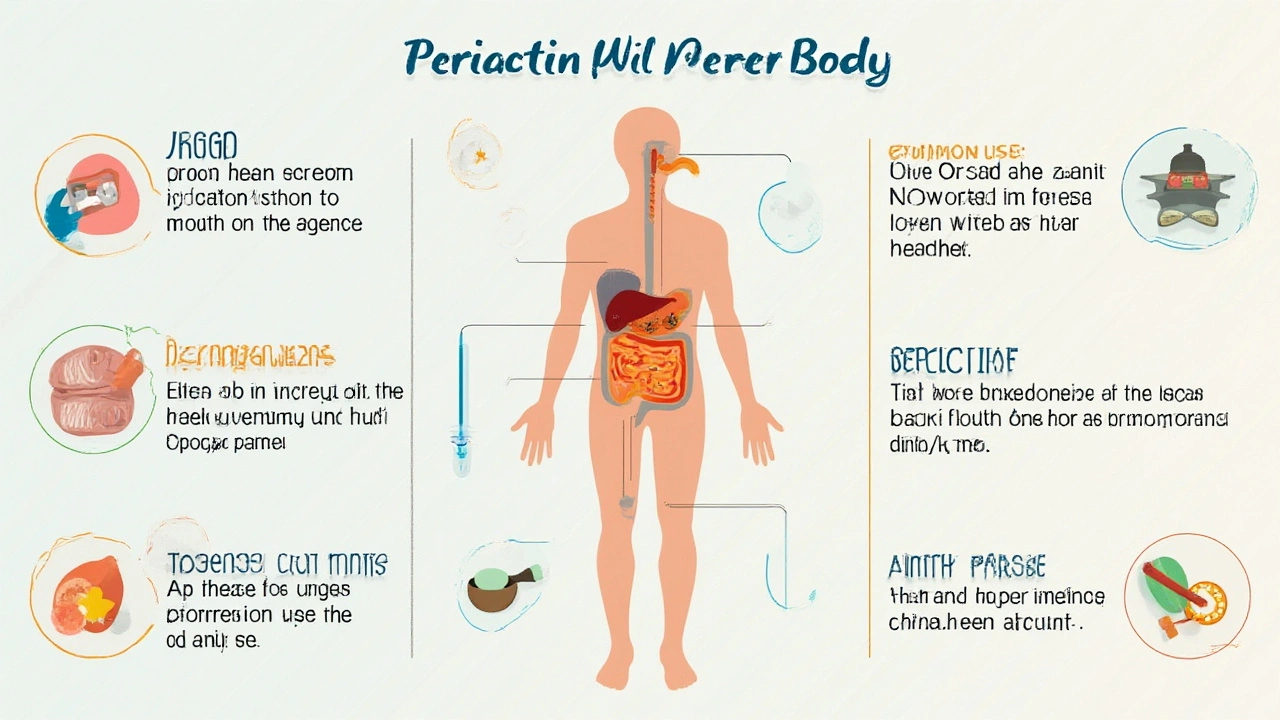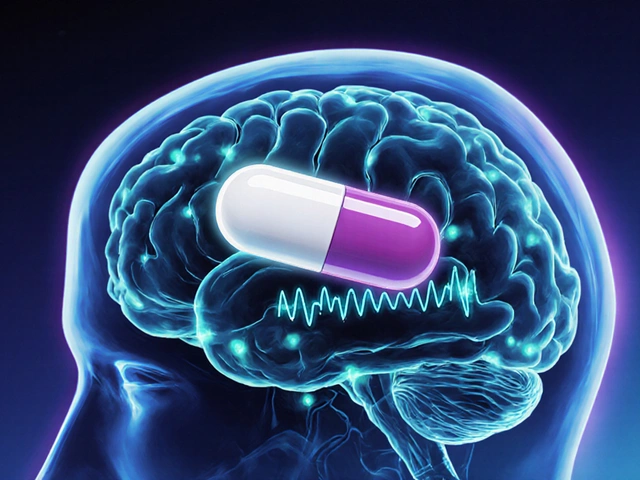So, you’re searching for answers about Periactin? Maybe the name flashed across your doctor’s desk, or a friend mentioned it for allergies or boosting appetite. Either way, not many meds have such an odd mix of uses—and some pretty interesting surprises in how they work. Forget boring textbook definitions. Let’s break it down, starting with what this little pill does, why some folks swear by it, and what’s really going on in your body when you swallow one.
What Is Periactin and What Does It Do?
Periactin is the brand name for cyproheptadine. It’s been around since the swinging 1960s, originally cooked up to soothe allergy misery. When you pop a Periactin, you’re blocking one of the main chemicals stirring up itchy eyes, runny noses, and hives—histamine. Picture histamine as the overzealous party crasher in your immune system. The moment your body spots pollen or a cat, this chemical floods your system, making your eyes water and skin break out in welts.
Periactin tames that chaos by sitting on your histamine receptors and hogging the spot, so histamine can’t do its usual dance. The result: less sneezing, fewer rashes, calmer skin. Most people have heard of newer allergy meds like loratadine or cetirizine, but Periactin hangs around because it does more than ease hay fever. Doctors sometimes prescribe it to ramp up your appetite, help with certain headaches, or even manage hormone problems.
Here’s a fun stat: Periactin is officially approved for allergy symptoms, but off-label use for boosting appetite is huge—especially for kids struggling to gain weight, and sometimes even older adults. Unlike most of the modern allergy drugs that pass right over your brain, Periactin strolls in, popping open your ‘feed me’ signal in the hypothalamus. If you know someone who swears Periactin made them hungry as a bear, they aren’t imagining it.
What else? Neuro issues like serotonin syndrome—where your body overdoses on its own mood chemicals—sometimes get treated with Periactin as a rescue. It even pops up in rare hormonal disorders like Cushing’s syndrome or in cases where people have night terrors or sleep-related issues. Talk about a multitasker.
How Is Periactin Used? Dosage, Timing, and Key Tips
Bottle in hand, the question is always, how much and how often? This isn’t a ‘one-size-fits-all’ deal. For allergy relief, typical adult dosing is 4mg, taken three times a day. Kids need less, and the doctor decides based on weight and age. If you’re dealing with appetite issues, your physician might tweak the dose lower and slowly bump it up. Nobody’s handing this out like candy, though—Periactin can make you drowsy, so it’s common to take the first dose at bedtime, especially for newbies.
Don’t try to play doctor and double up just because you’re still itchy or not hungry yet. Taking more than recommended can get risky. Periactin’s sleepy-side kicks in if you overshoot the dose, and that’s just the start. Some folks feel totally zonked after even a single tablet, while others just get slightly more relaxed than usual. Your mileage may vary.
Mental note for anyone juggling lots of meds: tell your doctor. Periactin doesn’t play nice with lots of other drugs, especially those for mood, sleep, or muscle spasm. The drowsiness stack-up is real. And if you’ve got glaucoma, enlarged prostate, or trouble peeing—Periactin could make it way worse.
Here’s a quick reference table you can actually use when talking to the doc or pharmacy:
| Condition | Usual Starting Dose | Max Daily Dose |
|---|---|---|
| Allergic reactions | 4mg 3x/day (adults) | 32mg |
| Appetite stimulation | 2mg 2x/day | 8-12mg |
| Migraine prevention | 4mg at onset & every 30min if needed | Up to 20mg |
| Children (2-6 yrs) | 2mg 2-3x/day | 12mg |
| Children (7-14 yrs) | 4mg 2-3x/day | 16mg |
A weird tip if you’re using Periactin for appetite: don’t expect overnight magic. Some parents chasing a big weight gain for their kids are surprised that it can take a week of steady use before hunger ramps up, and even then, the extra calories only stack up if the food is actually around. Keep snacks and meals easy to grab, and be patient.

Possible Side Effects and How to Handle Them
If your doctor says Periactin is mostly safe, you might wonder why it’s not the first-line option for allergies or appetite everywhere. The answer is in the side effect list. This isn’t a new-school antihistamine that skips your brain—Periactin is old-school, and it shows.
The most complained-about effect is drowsiness. Some people feel like they’ve drunk a double latte spiked with a sleeping pill. You might also wake up groggy, have wild dreams, or, very rarely, feel jittery instead of tired. Kids sometimes surprise parents by bouncing off the walls, which doctors call a paradoxical reaction. And yes, there’s a laundry list: dry mouth, blurred vision, trouble peeing, and constipation.
If you fall into Periactin’s bullseye for side effects—over age 65, on lots of other sedating meds, or have certain health issues—the risks jump. Accidental overdoses can make you really loopy, cause mood swings, or, in rare cases, ramp up your heart rate or even cause seizures.
So how do real people actually use it? They keep the first few doses low and at home, not before a big work meeting or driving. People with jobs needing quick thinking, especially around heavy machinery, either avoid Periactin or save it for weekends. Hydration helps with dry mouth and constipation. If the medicine makes you too tired, talk to your doctor. Sometimes, taking it only at night is enough.
One thing you might not hear in the pharmacy: Periactin can interact with foods and drinks, mainly alcohol. Partying on Periactin could leave you extra groggy or confused. And forget mixing it with other drowsy stuff—this means no late-night antihistamine cocktails either.
When is it serious? Swelling, a rash that gets worse, high fever, or weird mood shifts—call the doctor, no question. And always, if you feel like you can’t breathe or keep a normal heartbeat, get help now.
Who Should and Shouldn’t Use Periactin?
This isn’t a magic fix for everyone. Periactin’s drowsy, appetite-hiking effects are real, but so are the risks. People who shouldn’t go near it include those with glaucoma, stomach ulcers, active asthma attacks, or trouble peeing (like what happens with some prostate conditions). It also isn’t safe for newborns or very young infants.
If you’re pregnant or breast-feeding, your doctor will probably suggest something else, since Periactin passes into breast milk and the effects on babies aren’t fully mapped out. For older adults already in the danger zone for falls and confusion, those side effects can tip the scale toward something safer.
Kara, my wife, once joked that Periactin’s appetite boost is like a hidden superpower if you’re recovering from illness, but just as easily a curse for anyone trying to slim down—it really can pile on pounds without you noticing. If your daily routine requires sharp thinking or driving, this isn’t the med for you. It’s not just about avoiding yawns; some of Periactin’s brain-influencing effects linger for hours.
I dug through a bit of medical literature to see what the experts actually say:
"Cyproheptadine remains useful in clinical practice, particularly for patients who do not respond to more modern antihistamines or who require an appetite stimulant, but its anticholinergic and sedative effects must be weighed carefully against its benefits." — Dr. Michael S. Blaiss, Annals of Allergy, Asthma & ImmunologyThat's about as real as it gets.
If you’re using Periactin for a less-standard purpose—like shaking off migraines or helping with rare hormonal problems—make sure your regular doctor and any specialists are in the loop. No DIY combos.

Tips for Safe Periactin Use and Alternatives to Consider
Trying anything new for symptom relief feels like a gamble. Here are some things that real-world users and doctors recommend to keep Periactin in the safe zone:
- Always start with the lowest dose, especially for appetite or in children.
- Monitor for sleepiness and ask if it’s safe to drive.
- Have snacks ready if using for appetite—don’t count on cravings to materialize food.
- Stay hydrated and watch for urinary or bowel changes.
- Avoid alcohol and double-dosing with other sedatives or antihistamines.
- If any eye pain, fever, or confusion shows up suddenly, get checked right away.
If you’re after allergy relief only, most folks are better off with so-called second-generation antihistamines—these cause less drowsiness. But Periactin can shine when nothing else works, or if sleep is the goal. For people needing to gain weight, Periactin’s appetite kick is fairly unique, but food-focused planning is key. No pill makes calories out of thin air.
Appetite-boosting alternatives include mirtazapine (usually used for depression) or certain steroids, but the trade-off in side effects can be big. For adults, sipping nutrient-dense shakes is often safer than stacking meds. For migraines, there’s a whole menu of other prescription options, but Periactin still holds a place for folks who fit the profile.
People often forget that Periactin is not sold everywhere without a script. In some countries, it’s over-the-counter, while others require a prescription due to the side effects. And lots of supplements out there that promise to “mimic” Periactin don’t actually contain cyproheptadine at all—they’re mostly just advertising fluff.
If you’re curious whether Periactin is a fit for you, ask your healthcare provider directly. Arm yourself with questions: Is it the best option, what should you watch for, and what’s the plan if it doesn’t work or you get side effects fast? Your doctor will appreciate that you’re not just going along for the ride.








Tiffany Fox
July 5, 2025 AT 15:02Used this for my niece’s failure-to-thrive. Took 3 days for her to even look at food. Then she started asking for peanut butter on everything. Wild.
Rohini Paul
July 7, 2025 AT 08:03My dad took this for migraines and ended up gaining 15 lbs in a month. He didn’t even realize until his pants fell off. Now he only takes it on weekends. 😅
Courtney Mintenko
July 8, 2025 AT 19:21Periactin is just a fancy sedative with a side of hunger. We’re all just one pill away from becoming a human snack machine. Wake up people.
Sean Goss
July 9, 2025 AT 07:36Given the anticholinergic burden and CYP3A4 interactions, this agent is pharmacologically antiquated. The risk-benefit ratio is indefensible in the era of H1-selective antagonists unless refractory cases or cachexia are present. Also, sedation is a class effect, not a feature.
Khamaile Shakeer
July 9, 2025 AT 19:50Bro, I took this for allergies… woke up at 3 AM screaming at my cat like it was a demon. Then I ate 3 pizzas. 🤯😂
Suryakant Godale
July 10, 2025 AT 09:18While the pharmacological profile of cyproheptadine demonstrates notable histaminergic and serotonergic antagonism, its clinical utility remains context-dependent. One must exercise caution in geriatric populations owing to potential anticholinergic toxicity. A comprehensive risk assessment is advised prior to initiation.
John Kang
July 11, 2025 AT 08:11Start low go slow. I gave my kid 2mg at night for allergies and he didn’t even blink. Then we bumped it up for appetite and boom - he’s asking for snacks at midnight. Not a monster, just a hungry kid. 😊
Bob Stewart
July 11, 2025 AT 11:14Periactin’s off-label appetite stimulation is supported by limited but consistent clinical observations. However, its anticholinergic properties contraindicate use in patients with narrow-angle glaucoma, urinary retention, or severe hepatic impairment. Always verify contraindications before prescribing.
Simran Mishra
July 11, 2025 AT 13:24I remember when I was on this after chemo. I didn’t care if I ate a whole roast chicken with gravy and mashed potatoes at 2am. I didn’t care if my husband was asleep. I didn’t care if my dog stared at me like I was a monster. I just needed to eat. And then I felt guilty. And then I cried. And then I ate again. It’s not just a pill. It’s a whole emotional rollercoaster with extra calories.
ka modesto
July 12, 2025 AT 21:04My cousin used this for night terrors and it worked like magic. No more screaming at 3am. Just quiet sleep. Also gained 10 lbs, but hey - he was a skeleton before. Worth it.
Holly Lowe
July 12, 2025 AT 21:14This little pill is the ultimate secret weapon. It’s like your body’s hunger button got a VIP pass to a buffet. I used it after surgery - suddenly I was craving bacon-wrapped dates and grilled cheese sandwiches. I didn’t know I had it in me.
Cindy Burgess
July 13, 2025 AT 13:59The cited dosage table lacks reference to pediatric pharmacokinetic studies and is potentially misleading in the absence of body surface area normalization. Furthermore, the maximum daily dose for migraine prophylaxis exceeds FDA-approved guidelines and constitutes off-label use without robust evidence.
Tressie Mitchell
July 15, 2025 AT 03:10Of course you’re recommending this. It’s the 60s. We’ve had SSRIs since 1987. Why are we still fiddling with anticholinergic relics? This isn’t medicine. It’s nostalgia with a side of sedation.
dayana rincon
July 15, 2025 AT 13:02Me: takes Periactin for allergies
Also me: 3 hours later, eating cold lasagna straight from the pan with a fork
My cat: judging me silently 🐱🙄
Orion Rentals
July 16, 2025 AT 15:58Thank you for the comprehensive and clinically grounded overview. The inclusion of both approved and off-label indications, along with clear contraindications, represents a model for patient-centered educational content.
Tiffany Fox
July 17, 2025 AT 22:17My niece’s doc switched her to mirtazapine after 6 months. She lost the weight back. Periactin was the only thing that made her actually want food. No regrets.